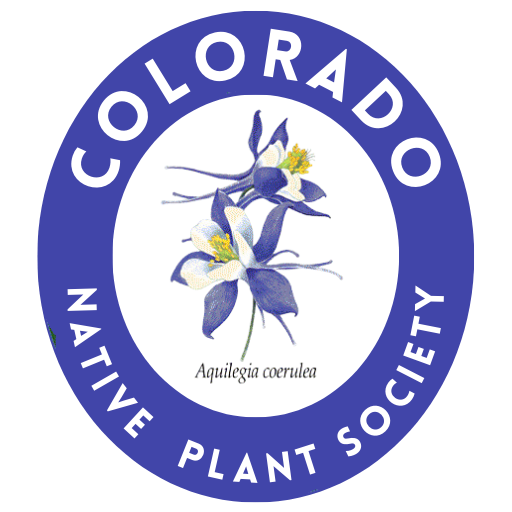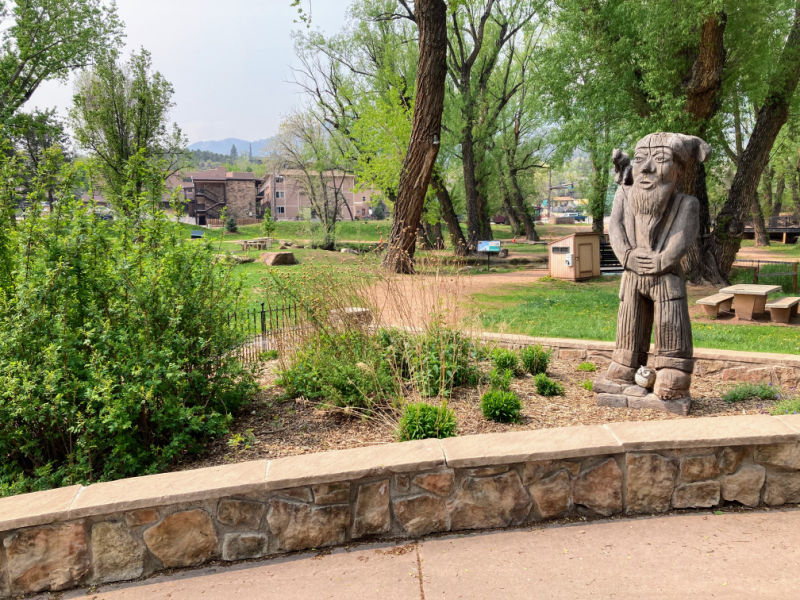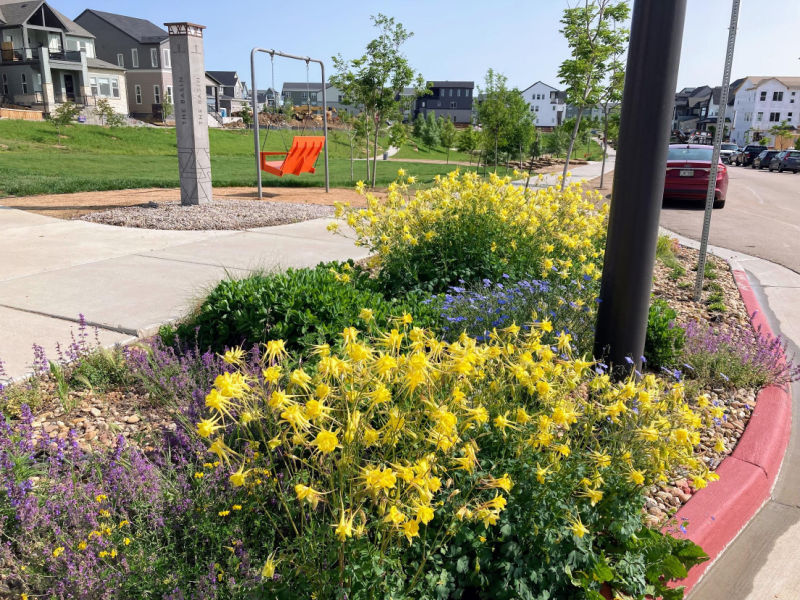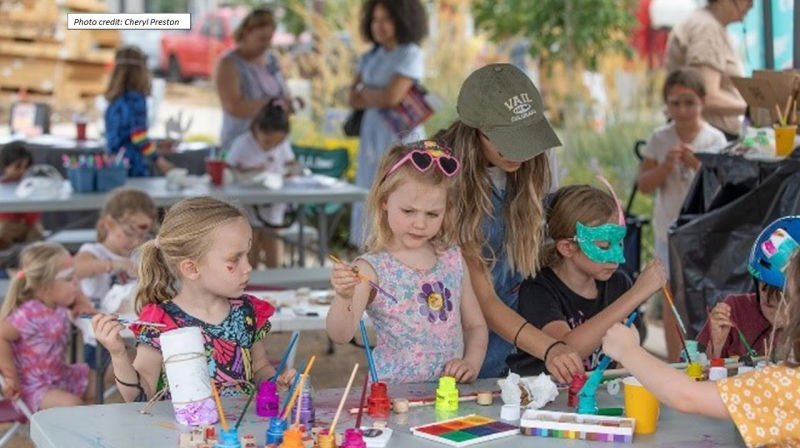Conservation is fun! Residents celebrate progress by holding Pollinator puppet parade at Manitou Springs’ Pollinator Party. Photo by Amy Yarger
Pollinators play a critical role in the food supply for wildlife and people, making pollinators keystone species in most terrestrial ecosystems. Pollinators also serve as charismatic and intriguing ambassadors for the natural world. Not every person will see a whale or a polar bear in their lifetime, but bees, butterflies and other insects impact all our lives, and our actions have a direct impact on them, too. Pollinator conservation is a field in which everyone can participate and make a positive difference, whether by planting a garden or being a community scientist. And the habitats that we protect for pollinators are healthier for humans, too. Colorado is a great place for pollinators, with over 1000 species of bee and over 250 species of butterfly, as well as wasps, moths, flies, beetles, hummingbirds and other flower visitors. There are many reasons for this pollinator diversity from a robust network
of natural areas to the presence of major rivers which can serve as biodiversity corridors. Colorado also features many biomes, due to the variation in altitude, climate and vegetation found throughout the state. But the state has also seen tremendous population growth which can result in the disturbance and destruction of habitat for pollinators and other wildlife.
One of Butterfly Pavilion’s programs for improving the future for pollinators and people is Pollinator Districts. A Pollinator District is a community, including home gardens, businesses, schools, public facilities, and parks, designed, constructed, and maintained in such a way that pollinator habitat demonstrates a net gain over time. To be certified as a Pollinator District, a community must demonstrate a measurable increase in pollinator habitat and track pollinator populations over time. In September 2022, Butterfly Pavilion certified the Baseline development in Broomfield as the first Pollinator District in the world. Just a few months later, in June 2023, Manitou Springs became the first municipal Pollinator District.
Manitou Springs became the first municipal Pollinator District in June, 2023. This pollinator garden is also Home of the Gnome!
This native plant streetscape in Baseline sparkles with golden columbine. Both photos courtesy of Amy Yarger.
Certification as a Pollinator District requires a process of interviews, plan and
document reviews and landscape assessments by Butterfly Pavilion’s science team.
Every community is different, so at first, Butterfly Pavilion meets with community
members to assess their starting point and their future vision. Butterfly Pavilion staff
then use a detailed rubric to record how land is managed and conserved, soil, water,
and vegetation, pollinator populations, and stewardship. Each community then
receives a detailed case study that outlines successes and recommendations based
on the rubric.
It’s exciting to document the progress that a community can make when they’ve
decided to make pollinators a priority. Since Baseline is new and growing, Butterfly
Pavilion works closely with planners and landscape architects to include native
plants and other components of pollinator habitat in every part of the development.
Our science team also visits throughout the year to make sure that pollinator
guidelines are implemented and to collect data about what pollinators are present
in the landscape. Our educators hold Family Nature Clubs and other events to
connect Baseline residents to the science and culture of pollinators. Residents
participate in pollinator bioblitzes via the iNaturalist app and feel that living in a
Pollinator District is part of their identity and values.
Golden northern bumblebee (B. fervidus) making use of Pollinator District garden in Baseline feeding on Rocky Mountain penstemon, Penstemon strictus. Photo by Amy Yarger
This work has seen significant results over the last four years. Prior to construction at
Baseline, Butterfly Pavilion scientists performed a pollinator survey at the Baseline site. The site consisted of sparse and degraded vegetation, dominated by weeds. Pollinator habitat was almost nonexistent, except for in the drainages and roadsides which supported scattered individuals of annual sunflowers (Helianthus annuus) and showy milkweed (Asclepias speciosa). At that time, we found 11 different families of pollinating insects, including sweat bees, mining bees, bee flies and spider wasps. Follow-up surveys at Baseline in 2022 and 2023
such as butterflies and 4 species of bumble bees. We also observed solitary bees such as green metallic bees, sweat bees, mining bees, and leafcutter bees for the first time.
Working with Manitou Springs was an exciting example of what an entire
municipality can do when volunteers, nonprofits, businesses, and city staff
collaborate. A group of residents called the Manitou Pollinators, led by Executive
Director Melody Daugherty, networked with local nurseries, schools, chambers of
commerce and more, to raise awareness and get buy-in from city government. They
organized an annual Pollinator Festival, bringing in hundreds of guests to learn and
celebrate. The Manitou Springs Parks Department crafted a plan to add pollinator
habitat to their park system each year and underwent training to learn how to
maintain these native plantings. This year, the entire city will be observing and
counting its pollinators to get a sense of how far they have come.
A pollinator celebration at Baseline – “people are the key ingredient of success.” Photo by Cheryl Preston
Pollinator District certification is not the end of the story for Baseline and Manitou
Springs. In both Baseline and Manitou Springs, people are the key ingredient of
success, and these pollinator protectors carry the vision of what communities can do for conservation. Butterfly Pavilion continues to work closely with both communities to ensure that pollinator habitat is conserved and improved over time and that everyone can get
involved in stewardship of these important animals. Our scientists also continue to collect data to have a more thorough understanding of plant-pollinator interactions in urbanized environments, especially important since the World Bank estimates that by 2050, over two-thirds of people will live in cities. With Pollinator Districts, we hope to create a vision of cities that welcome nature and connect people with the well-being of the planet, their communities, and themselves.
Amy Yarger
Senior Director of Horticulture,
Butterfly Pavilion





